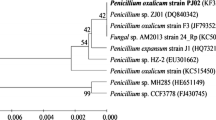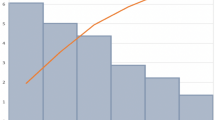Abstract
The objective of this study was to use statistically based experimental designs for the optimization of xylanase production from Alternaria mali ND-16. Ten components in the medium were screened for nutritional requirements. Three nutritional components, including NH4Cl, urea, and MgSO4, were identified to significantly affect the xylanase production by using the Plackett–Burman experimental design. These three major components were subsequently optimized using the Doehlert experimental design. By using response surface methodology and canonical analysis, the optimal concentrations for xylanase production were: NH4Cl 11.34 g L−1, urea 1.26 g L−1, and MgSO4 0.98 g L−1. Under these optimal conditions, the xylanase activity from A. mali ND-16 reached 30.35 U mL−1. Verification of the optimization showed that xylanase production of 31.26 U mL−1 was achieved.


Similar content being viewed by others
References
Cowieson AJ, Hruby M, Isaksen MF (2005) The effect of conditioning temperature and exogenous xylanase addition on the viscosity of wheat-based diets and the performance of broiler chickens. Br Poult Sci 46:717–724
Cui F, Li Y, Xu Z, Xu H, Sun K, Tao W (2006) Optimization of the medium composition for production of mycelial biomass and exo-polymer by Grifola frondosa GF9801 using response surface methodology. Bioresour Technol 97:1209–1216
Dobrev GT, Pishtiyski IG, Stanchev VS, Mircheva R (2007) Optimization of nutrient medium containing agricultural wastes for xylanase production by Aspergillus niger B03 using optimal composite experimental design. Bioresour Technol 98:2671–2678
Doehlert DH (1970) Uniform shell designs. Appl Stat 19:231–239
George SP, Ahmad A, Rao MB (2001) A novel thermostable xylanase from Thermomonospora sp.: influence of additive on thermostability. Bioresour Technol 78:221–224
Haaland PD (1989) Separating signals from the noise. In: Haaland PD (ed) Experimental design in biotechnology. Marcel Dekker, New York, pp 61–83
Korn MGA, Santos WPC, Kornc M, Ferreira SLC (2005) Optimisation of focused-microwave assisted digestion procedure for Kjeldahl nitrogen determination in bean samples by factorial design and Doehlert design. Talanta 65:710–715
Lemos JLS, Fontes MCA, Jr NP (2001) Xylanase production by Aspergillus awamori in solid-state fermentation and influence of different nitrogen sources. Appl Biochem Biotechnol 91-3:681–689
Li Y, Lu J, Gu GX, Mao Z (2005) Characterization of the enzymatic degradation of arabinoxylans in grist containing wheat malt using response surface methodology. J Am Soc Brew Chem 63:171–176
Li Y, Lin J, Meng D, Lu J, Gu G, Mao Z (2006) Effect of pH, cultivation time and substrate concentration on the xylanase production by Aspergillus awamori ZH-26 under submerged fermentation using central composite rotary design. Food Technol Biotechnol 44:473–477
Li Y, Cui F, Liu Z, Xu Y, Zhao H (2007a) Improvement of xylanase production by Penicillium oxalicum ZH-30 using response surface methodology. Enzyme Microb Technol 40:1381–1388
Li Y, Liu Z, Zhao H, Xu Y, Cui F (2007b) Statistical optimization of xylanase production from new isolated Penicillium oxalicum ZH-30 in submerged fermentation. Biochem Eng J 34:82–86
Li Y, Liu Z, Cui F, Xu Y, Zhao H (2007c) Application of statistical experimental design to optimize culture requirements of a novel Aspergillus sp. . ZH-26 producing endoxylanase from agricultural waste material and evaluation of its performance on the degradation of arabinoxylans in mashing. J Food Sci 72:320–329
Lu J, Li Y, Gu GX, Mao Z (2005) Effects of molecular weight and concentration of arabinoxylans on the membrane plugging. J Agric Food Chem 53:4996–5002
Miller GL (1959) Use of dinitrosalicylic acid reagent for determination of reducing sugars. Anal Chem 31:426–428
Montgomery DC (1997) Design and analysis of experiments, 4th edn. Wiley, New York
Pham PL, Taillandier P, Delmas M, Strehaiano P (1998) Optimization of a culture medium for xylanase production by Bacillus sp. using statistical experimental designs. World J Microbiol Biotechnol 14:185–190
Plackett RL, Burman JP (1946) The design of optimum multifactorial experiments. Biometrika 37:305–25
Selinheimo E, Kruus K, Buchert J, Hopia A, Autio K (2006) Effects of laccase, xylanase and their combination on the rheological properties of wheat doughs. J Cereal Sci 43:152–159
Senthilkumar SR, Ashokkumar B, Raj KC, Gunasekaran P (2005) Optimization of medium composition for alkali-stable xylanase production by Aspergillus fischeri Fxn 1 in solid-state fermentation using central composite rotary design. Bioresour Technol 96:1380–1386
Siedenberg D, Gerlach SR, Weigel B, Schugerl K, Giuseppin MLF, Hunik J (1997) Production of xylanase by Aspergillus awamori on synthetic medium in stirred tank and airlift tower loop reactors: the influence of stirrer speed and phosphate concentration. J Biotechnol 56:103–114
Taragano VM, Pilosof AMR (1999) Application of Doehlert designs for water activity, pH, and fermentation time optimization for Aspergillus niger pectinolytic activities production in solid-state and submerged fermentation. Enzyme Microb Technol 25:411–419
Vanot G, Deyris V, Guilhem M-C, Luu RPT, Comeau L-C (2001) Optimal design for the maximization of Penicillium cyclopium lipase production. Appl Microbiol Biotechnol 57:342–345
Vicuna R, Oyarzum E, Osses M (1995) Assessment of various commercial enzymes in the bleaching of radiata pine kraft pulps. J Biotechnol 40:163–168
Wejse PL, Ingovorsen K, Mortensen KK (2003) Xylanase production by a novel halophilic bacterium increased 20-fold by response surface methodology. Enzyme Microb Technol 32:721–727
Author information
Authors and Affiliations
Corresponding author
Rights and permissions
About this article
Cite this article
Li, Y., Liu, Z., Cui, F. et al. Application of Plackett–Burman experimental design and Doehlert design to evaluate nutritional requirements for xylanase production by Alternaria mali ND-16. Appl Microbiol Biotechnol 77, 285–291 (2007). https://doi.org/10.1007/s00253-007-1167-6
Received:
Revised:
Accepted:
Published:
Issue Date:
DOI: https://doi.org/10.1007/s00253-007-1167-6




